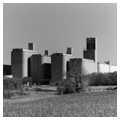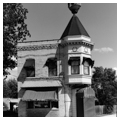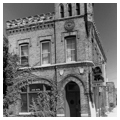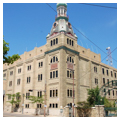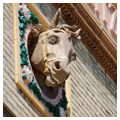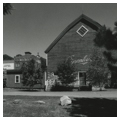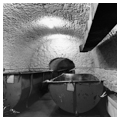Milwaukee dominated America’s beer-brewing industry in the nineteenth century. In large part this dominance was due to the city’s extensive German community. Among the great names of American brewing are Pabst, Schlitz, and Blatz. All three companies built sprawling complexes that each covered several of Milwaukee’s city blocks. These complexes comprised several inter-connected buildings that housed different stages of the brewing process from grain stores to malt houses, brewhouses, bottling works, shipping warehouses, and stables. They also included company office buildings, tap rooms, and beer gardens, where visitors could sample the wares in a decorative, Teutonic setting.
Around 1900 the Pabst Brewing Company was the world’s largest brewery, annually shipping one million barrels nationwide. Its architecture is typical of breweries. The masonry buildings, a picturesque blend of German castles and Gothic Revival, feature crenellated turrets, rusticated arches, stepped gables, and ornate towers.
Beer production was not limited to Milwaukee. In 1867 Jacob Leinenkugel established a brewing company in Chippewa Falls. Bohemian-born Wojta Stransky built the Ahnapee Brewery; now a winery in 1869 in Algoma for this community of largely Bohemian and German immigrants. And Columbus boasted three breweries, the largest of which was the Kurth Brewery.
Some of the buildings that supplied and processed the raw ingredients for beer still exist. The Beaumont Hop House, where flowers were dried, is in the town of Merton. Although most brewers did their own malting in the early years, a brewing boom in the 1860s and 1870s fostered a separate malting industry. The Ladish Malt Company Complex in Jefferson County survives to record that part of the brewing story.
In the early years brewers transported beer in kegs, using wagons pulled by horses. A few horse barns and stables remain, notably at the Leinenkugel brewery and at the Joseph Schlitz Brewing Company. Refrigeration and the perfection of the bottle cap made it possible to ship beer long distances by rail.
The final and important buildings were for the consumption of beer. Breweries established taverns to entice and create loyal consumers. In the late nineteenth century the Pabst Brewing Company opened taverns throughout the Midwest, especially in German ethnic neighborhoods. A fine example in Milwaukee is the Pabst Tavern, which—true to the castellated architectural theme of breweries—features battlemented brick walls and a three-story tower. Pabst’s saloon in Racine echoes the Gothic Revival Milwaukee brewery, making it an architectural advertisement for the company. The former Schlitz Brewing Company Saloon still carries the company’s trademark banded globe on its polygonal corner turret. Although Prohibition closed these taverns, many of their buildings were reborn as restaurants or reemerged as tap rooms once Prohibition ended.
Writing Credits
If SAH Archipedia has been useful to you, please consider supporting it.
SAH Archipedia tells the story of the United States through its buildings, landscapes, and cities. This freely available resource empowers the public with authoritative knowledge that deepens their understanding and appreciation of the built environment. But the Society of Architectural Historians, which created SAH Archipedia with University of Virginia Press, needs your support to maintain the high-caliber research, writing, photography, cartography, editing, design, and programming that make SAH Archipedia a trusted online resource available to all who value the history of place, heritage tourism, and learning.


